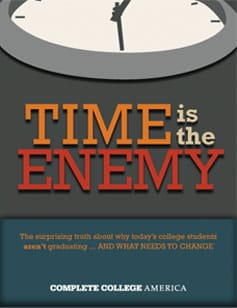 College readiness has become the cause célèbre for many education
reformers and policy pundits. High-performing charter networks like KIPP and
Achievement First chant the “college-ready” mantra to their students daily.
Within his first six months in office, President Obama announced a desire to have 60 percent of young Americans
be college educated. Yet a recent analysis by Complete College America finds
that, despite valiant efforts to increase our college-enrollment rates (which have upped from 36 percent to 41 percent of
young Americans over the past decade), our college-completion
rates have stagnated—and are unacceptably low. In Texas,
for example, 79 percent of public-college students enrolled at a
community
college—yet fewer than 5 percent of those individuals earned their
associate
degree on time. And the numbers for four-year colleges are no better:
Only a
quarter of Lone Star students enrolling in a bachelor’s program
graduated in
four years. Double that time frame and 60 percent of those who
matriculated
graduated. Better preparing students for the rigors of post-secondary
academic
work will do much to up these numbers. But these findings raise another
important question: With this many college dropouts, are we right to
pursue the “college for all” strategy singularly? Preparing students for
trade programs
and apprenticeships (or the military) may prove just as valuable to
shoring up
a strong middle class and giving decent futures to individuals. We
suspect that
many who were pushed into college, only to realize a year (and many
dollars)
later that it isn’t for them, might agree that “and career-readiness” is
a
worthy pursuit.
College readiness has become the cause célèbre for many education
reformers and policy pundits. High-performing charter networks like KIPP and
Achievement First chant the “college-ready” mantra to their students daily.
Within his first six months in office, President Obama announced a desire to have 60 percent of young Americans
be college educated. Yet a recent analysis by Complete College America finds
that, despite valiant efforts to increase our college-enrollment rates (which have upped from 36 percent to 41 percent of
young Americans over the past decade), our college-completion
rates have stagnated—and are unacceptably low. In Texas,
for example, 79 percent of public-college students enrolled at a
community
college—yet fewer than 5 percent of those individuals earned their
associate
degree on time. And the numbers for four-year colleges are no better:
Only a
quarter of Lone Star students enrolling in a bachelor’s program
graduated in
four years. Double that time frame and 60 percent of those who
matriculated
graduated. Better preparing students for the rigors of post-secondary
academic
work will do much to up these numbers. But these findings raise another
important question: With this many college dropouts, are we right to
pursue the “college for all” strategy singularly? Preparing students for
trade programs
and apprenticeships (or the military) may prove just as valuable to
shoring up
a strong middle class and giving decent futures to individuals. We
suspect that
many who were pushed into college, only to realize a year (and many
dollars)
later that it isn’t for them, might agree that “and career-readiness” is
a
worthy pursuit.
|
“College Graduation Rates Are Stagnant Even as Enrollment Rises, a Study Finds,” by Tamar Lewin, New York Times, September 27, 2011. “Obama Urges Students to Set Their Sights on College,” by Mark Landler, September 28, 2011. Complete College America, “Time is the Enemy” (Complete College America, 2011). |